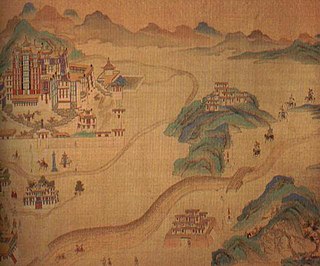
Tibet is a region in the central part of East Asia, covering much of the Tibetan Plateau and spanning about 2,500,000 km2 (970,000 sq mi). It is the homeland of the Tibetan people. Also resident on the plateau are some other ethnic groups such as the Monpa, Tamang, Qiang, Sherpa and Lhoba peoples and, since the 20th century, considerable numbers of Han Chinese and Hui settlers. Since the annexation of Tibet by the People's Republic of China in 1951, the entire plateau has been under the administration of the People's Republic of China. Tibet is divided administratively into the Tibet Autonomous Region, and parts of the Qinghai and Sichuan provinces. Tibet is also constitutionally claimed by the Republic of China as the Tibet Area since 1912.

While the Tibetan plateau has been inhabited since pre-historic times, most of Tibet's history went unrecorded until the introduction of Tibetan Buddhism around the 6th century. Tibetan texts refer to the kingdom of Zhangzhung as the precursor of later Tibetan kingdoms and the originators of the Bon religion. While mythical accounts of early rulers of the Yarlung Dynasty exist, historical accounts begin with the introduction of Buddhism from Nepal in the 6th century and the appearance of envoys from the unified Tibetan Empire in the 7th century. Following the dissolution of the empire and a period of fragmentation in the 9th-10th centuries, a Buddhist revival in the 10th–12th centuries saw the development of three of the four major schools of Tibetan Buddhism.
The foreign relations of Tibet are documented from the 7th century onward, when Buddhism was introduced by missionaries from India and Nepal. The Tibetan Empire fought with the Tang dynasty for control over territory dozens of times, despite peace marriage twice. Tibet was conquered by the Mongol Empire and that changed its internal system of government, introducing the Dalai Lamas, as well as subjecting Tibet to political rule under the Yuan dynasty. Tibetan foreign relations during the Ming dynasty are opaque, with Tibet being either a tributary state or under full Chinese sovereignty. But by the 18th century, the Qing dynasty indisputably made Tibet a subject. In the early 20th century, after a successful invasion, Britain established a trading relationship with Tibet and was permitted limited diplomatic access to "Outer Tibet", basically Shigatse and Lhasa. Britain supported Tibetan autonomy under the 13th Dalai Lama but did not contest Chinese suzerainty; while "Inner Tibet", areas such as Amdo and Kham with mixed Chinese and Tibetan populations to the east and north, remained nominally under the control of the Republic of China although that control was seldom effective. Although the sovereignty of Tibet was unrecognized, Tibet was courted in unofficial visits from Nazi Germany, Imperial Japan, and the United States during and after World War II. The foreign relations of Tibet ended with the Seventeen Point Agreement that formalized Chinese sovereignty over most all of political Tibet in 1951.

Kham is one of the three traditional Tibetan regions, the others being Amdo in the northeast, and Ü-Tsang in central Tibet. The original residents of Kham are called Khampas, and were governed locally by chieftains and monasteries. Kham presently covers a land area distributed between five regions in China, most of it in Tibet Autonomous Region and Sichuan, with smaller portions located within Qinghai, Gansu and Yunnan provinces.

Jelep La elevation 14,390 feet (4,390 m), is a high mountain pass between Sikkim, India and Tibet Autonomous Region, China. It is on a route that connects Lhasa to India. The pass is about 4 km (2.5 mi) south of Nathu La and is slightly higher. It was frequently used for trade between Tibet and India during the British Raj, with Kalimpong serving as the contact point. The Menmecho Lake lies below the Jelep La.

The British expedition to Tibet, also known as the Younghusband expedition, began in December 1903 and lasted until September 1904. The expedition was effectively a temporary invasion by British Indian Armed Forces under the auspices of the Tibet Frontier Commission, whose purported mission was to establish diplomatic relations and resolve the dispute over the border between Tibet and Sikkim. In the nineteenth century, the British had conquered Burma and Sikkim, with the whole southern flank of Tibet coming under the control of the British Indian Empire. Tibet ruled by the Dalai Lama under the Ganden Phodrang government was a Himalayan state under the protectorate of the Chinese Qing dynasty until the 1911 Revolution, after which a period of de facto Tibetan independence (1912–1951) followed.
The Japanese expedition to Tibet was an intelligence mission undertaken by Jinzō Nomoto in Tibet in 1939.
Sino-Tibetan relations may refer to:

The following outline is provided as an overview of and topical guide to Tibet:

The Sino-Tibetan War, or Second Sino-Tibetan War, was a war that began in May and June 1930 when the Tibetan Army under the 13th Dalai Lama invaded the Chinese-administered eastern Kham region, and the Yushu region in Qinghai, in a struggle over control and corvée labor in Dajin Monastery. The Tibetan Army, with support of the British, easily defeated the Sichuan army, which was focused on internal fights. Ma clique warlord Ma Bufang secretly sent a telegram to Sichuan warlord Liu Wenhui and the leader of the Republic of China, Chiang Kai-shek, suggesting a joint attack on the Tibetan forces. The Republic of China then defeated the Tibetan armies and recaptured its lost territory.

The Battle of Chamdo occurred from 6 to 24 October 1950. It was a military campaign by the People's Republic of China (PRC) to take the Chamdo Region from a de facto independent Tibetan state. The campaign resulted in the capture of Chamdo and the annexation of Tibet by the People's Republic of China.
The Nepal–Tibet War of 1855-1856 was fought in Tibet between the forces of the Tibetan government and the invading Nepalese army, resulting in huge loss of money and manpower for Tibet and Nepal. In 1856 the war ended with the Treaty of Thapathali.

The Sino-Nepalese War, also known as the Sino-Gorkha War and in Chinese as the campaign of Gorkha, was a war fought between the Qing dynasty of China and the Kingdom of Nepal in the late 18th century following an invasion of Tibet by the Nepalese Gorkhas. It was initially fought between Gorkhas and Tibetan armies in 1788 over a trade dispute related to a long-standing problem of low-quality coins manufactured by Nepal for Tibet. The Nepalese Army under Bahadur Shah plundered Tibet which was a Qing protectorate and Tibetans signed the Treaty of Kerung paying annual tribute to Nepal. However, Tibetans requested Chinese intervention and the Chinese imperial military forces under Fuk'anggan were sent to Tibet and repulsed the Gurkhas from the Tibetan plateau in 1792. Sino-Tibetan forces marched into Nepal up to Nuwakot but faced a strong Nepalese counterattack. Thus, both countries signed the Treaty of Betrawati as a stalemate. The war ended with Nepal accepting terms dictated by China. Nepal became a tribute state under Qing. Nepal paid tribute to China in 1792, 1794, 1795, 1823, 1842 and 1865. Both Nepal and Tibet had also agreed to accept the suzerainty of the Qing emperor.
The Dogra–Tibetan war or Sino-Sikh war was fought from May 1841 to August 1842, between the forces of the Dogra nobleman Gulab Singh of Jammu, under the suzerainty of the Sikh Empire, and those of Tibet, under the protectorate of the Qing dynasty. Gulab Singh's commander was the able general Zorawar Singh Kahluria, who, after the conquest of Ladakh, attempted to extend its boundaries in order to control the trade routes into Ladakh. Zorawar Singh's campaign, suffering from the effects of inclement weather, suffered a defeat at Taklakot (Purang) and Singh was killed. The Tibetans then advanced on Ladakh. Gulab Singh sent reinforcements under the command of his nephew Jawahir Singh. A subsequent battle near Chushul in 1842 led to a Tibetan defeat. A treaty was signed in 1842 maintaining the status quo ante bellum.

The Tibet Area was a province-level administrative division of China from 1912 to 1965. It was created by the Republic of China (ROC) following the 1911 Revolution, and nominally included the Ü-Tsang and Ngari areas, but not the Amdo and Kham areas. The territories were merely claimed by the ROC, but actually controlled by an independent Tibet with a government headed by the Dalai Lama in Lhasa.. The ROC was defeated during the Chinese Civil War; it retreated to Taiwan and lost control of mainland China to the People's Republic of China (PRC) in 1949; afterwards, the ROC continued to claim Tibet.
The Battle of Dartsedo was fought on January 28, 1701, between the Qing and Tibetan armies over the control of the strategic border town of Dartsedo.

The 1720 Chinese expedition to Tibet or the Chinese conquest of Tibet in 1720 was a military expedition sent by the Qing dynasty to expel the invading forces of the Dzungar Khanate from Tibet and establish Qing rule over the region, which lasted until the empire's fall in 1912.
Expedition to Tibet can refer to:
Sino-Tibetan or Chinese-Tibetan can refer to:

Tibet–India relations are said to have begun during the spread of Buddhism to Tibet from India during the 6th century AD. In 1959, the Dalai Lama fled to India after the failed 1959 Tibetan uprising. Since then, Tibetans-in-exile have been given asylum in India, with the Indian government accommodating them into 45 residential settlements across 10 states in the country, creating the Tibetan diaspora. From around 150,000 Tibetan refugees in 2011, the number fell to 85,000 in 2018, according to government data. Many Tibetans are now leaving India to go back to Tibet and other countries such as United States or Germany. The Government of India, soon after India's independence in 1947, treated Tibet as a de facto independent country. However, more recently India's policy on Tibet has been mindful of Chinese sensibilities, and has recognized Tibet as a part of China.











